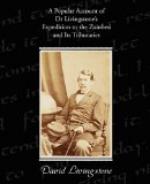It having been doubted whether sugar-cane is indigenous to this country or not, we employed Katosa to procure the two varieties commonly cultivated, with the intention of conveying them to Johanna. One is yellow, and the other, like what we observed in the Barotse Valley, is variegated with dark red and yellow patches, or all red. We have seen it “arrow,” or blossom. Bamboos also run to seed, and the people are said to use the seed as food. The sugar-cane has native names, which would lead us to believe it to be indigenous. Here it is called Zimbi, further south Mesari, and in the centre of the country Meshuati. Anything introduced in recent times, as maize, superior cotton, or cassava, has a name implying its foreign origin.
Katosa’s village was embowered among gigantic trees of fine timber: several caffiaceous bushes, with berries closely resembling those of the common coffee, grew near, but no use had ever been made of them. There are several cinchonaceous trees also in the country; and some of the wild fruits are so good as to cause a feeling of regret that they have not been improved by cultivation, or whatever else brought ours to their present perfection. Katosa lamented that this locality was so inferior to his former place at Pamalombe; there he had maize at the different stages of growth throughout the year. To us, however, he seemed, by digging holes, and taking advantage of the moisture beneath, to have succeeded pretty well in raising crops at this the driest time. The Makololo remarked that “here the maize had no season,”—meaning that the whole year was proper for its growth and ripening. By irrigation a succession of crops of grain might be raised anywhere within the south intertropical region of Africa.
When we were with Motunda, on the 20th October, he told us frankly that all the native provisions were hidden in Kirk’s Range, and his village being the last place where a supply of grain could be purchased before we reached the ship, we waited till he had sent to his hidden stores. The upland country, beyond the mountains now on our right, is called Deza, and is inhabited by Maravi, who are only another tribe of Manganja. The paramount chief is called Kabambe, and he, having never been visited by war, lives in peace and plenty. Goats and sheep thrive; and Nyango, the chieftainess further to the south, has herds of horned cattle. The country being elevated is said to be cold, and there are large grassy plains on it which are destitute of trees. The Maravi are reported to be brave, and good marksmen with the bow; but, throughout all the country we have traversed, guns are enabling the trading tribes to overcome the agricultural and manufacturing classes.




